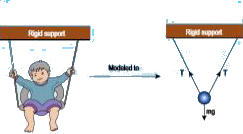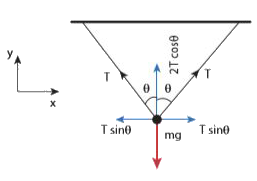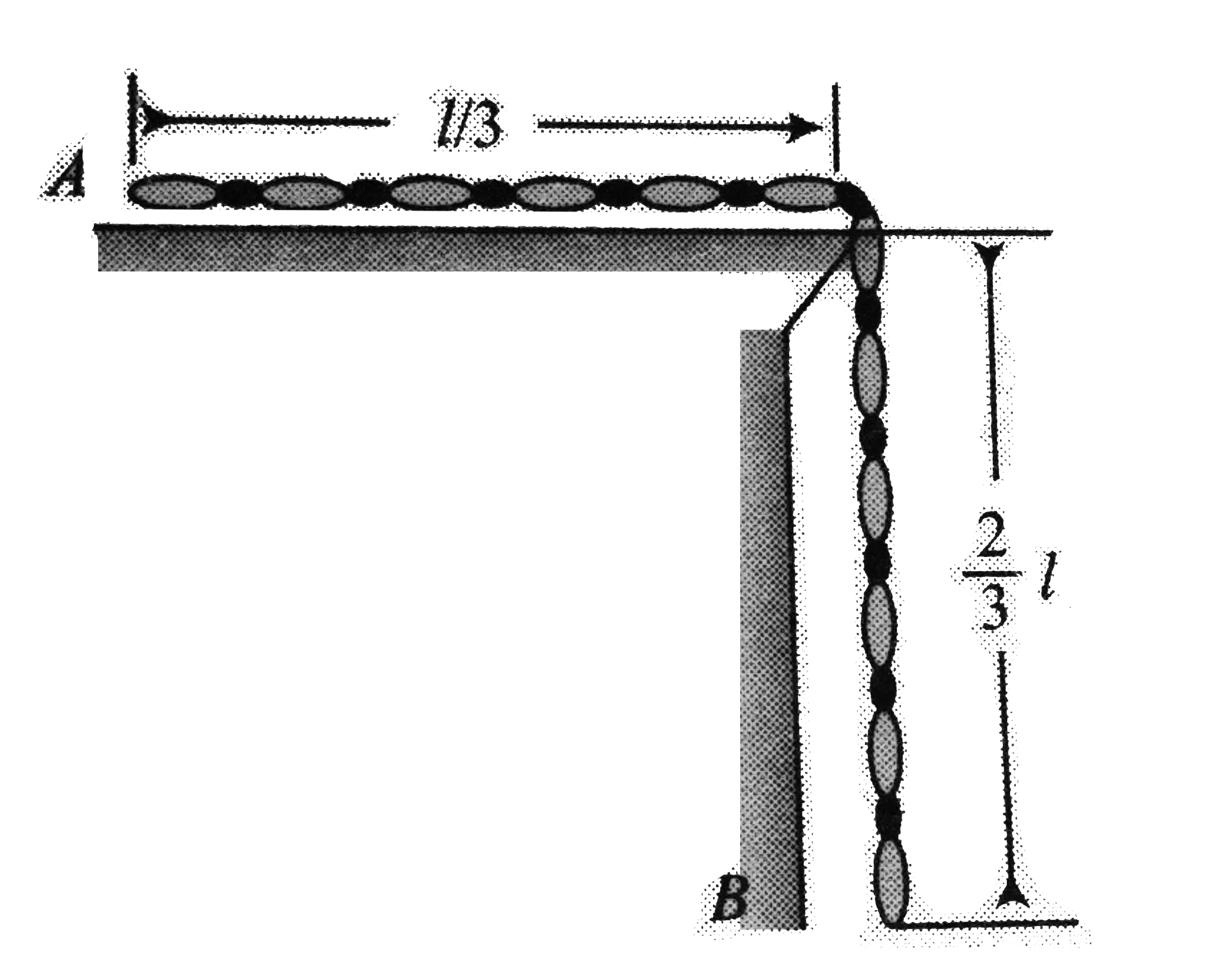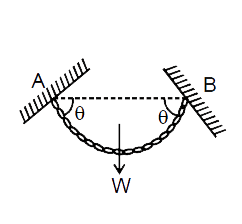A baby is playing in a swing which is hanging with the help of two identical chains is at rest. Identify the forces acting on the baby. Apply Lami’s theorem and find out the tension acting on the chain.

The baby and the chains are modeled as a particle hung by two strings as shown in the figure. Th ere are three forces acting on the baby.
i) Downward gravitational force along negative y direction (mg)
ii) Tension (T) along the two strings These three forces are coplanar as well as concurrent as shown in the following figure.

By using Lami’s theorem
Tsin(180−θ)=Tsin(180−θ)=mgsin(2θ)
Since sin(180−θ)=sinθandsin(2θ)=sinθcosθ
We get Tsinθ=mg2sinθcosθ From this, the tension on each string is T=mg2cosθ
Topper's Solved these Questions
- LAWS OF MOTIONBOOK - NCERT TAMILCHAPTER - LAWS OF MOTIONEXERCISE - EXERCISE ( I. Multiple Choice Questions)
15 Videos
- LAWS OF MOTIONBOOK - NCERT TAMILCHAPTER - LAWS OF MOTIONEXERCISE - EXERCISE (V. Numerical Problems)
14 Videos
- LAW OF MOTIONBOOK - NCERT TAMILCHAPTER - LAW OF MOTIONEXERCISE - EXERCISE (ADDITIONAL EXERCISE)
17 Videos
- MECHANICAL PROPERTIES OF FLUIDS BOOK - NCERT TAMILCHAPTER - MECHANICAL PROPERTIES OF FLUIDS EXERCISE - EXERCISE
45 Videos
Similar Questions
A uniform chain of mass m and length l is at the verge of sliding under the effect of gravity of the hanging part. Find the

a. coefficient of friction, between chain and table.
b. work done by friction and gravity till the chain leaves the table if the hanging part is pulled gently and released.
c. speed of the chain at the time of leaving the table in part (b) .
d. work done by the external force acting at the end A of the chain in slowly pulling the chain completely onto the table.
View SolutionA uniform chain of mass m and length l is at the verge of sliding under the effect of gravity of the hanging part. Find the

a. coefficient of friction, between chain and table.
b. work done by friction and gravity till the chain leaves the table if the hanging part is pulled gently and released.
c. speed of the chain at the time of leaving the table in part (b) .
d. work done by the external force acting at the end A of the chain in slowly pulling the chain completely onto the table.
View Solution
Knowledge Check
A book is lying at rest on the surface of a table. Which one of the following statements is true about the force(s) acting on it?
AOnly frictional force is acting on it.BThere is no force acting on it.CThere is a pair of balanced forces acting on it.DOnly gravitational force is acting on it.A book is lying at rest on the surface of a table. Which one of the following statements is true about the force (s) acting on it ?
AThere is a pair of balanced forces acting on itBOnly gravitational force is acting on itCOnly frictional force is acting on itDThere is no force acting on itThe greatest and the leat resultant of two forces acting at point are 12N and 8N respectively. Find out the forces.
A12N&8NB4N&8NC3N&9ND10N&2N
A force 50 N acts on a block A of mass 3 kg which is in contact with a block B of mass 2 kg, as shown in the figure. Find the forces acting on A and B. Will the same forces act on A and B if instead of applying the force to A, it is applied to B?

View SolutionA force 50 N acts on a block A of mass 3 kg which is in contact with a block B of mass 2 kg, as shown in the figure. Find the forces acting on A and B. Will the same forces act on A and B if instead of applying the force to A, it is applied to B?

View SolutionA flexible but inextensible chain of length l is placed on a smooth table with an initial length 1=nl hanging down the table. Calcultae the velocity with which the chain will leave the table if released from rest. Consider two cases : (i) the hanging part does not touch the ground which is at a large distance, (ii) the lower end of the hanging part initially just touches the ground. Also calculate the time in which the chain leaves the table in the first case
[Hint : Taking the table as the datum and m as the mass per unit length of the chain, apply the principle of conservation of energy].
View SolutionA force of 4N acts on a body of mass 2kg for 4s. Assuming the body to be initially at rest, find (a) its velocity when the force stops acting (b) the distance covered in 10s after the force starts acting.
View SolutionA flexible chain of weight W hangs between two fixed points A & B which are at the same horizontal level. The inclination of the chain with the horizontal at both the points of support is θ . What is the tension of the chain at the mid point ?

View Solution
